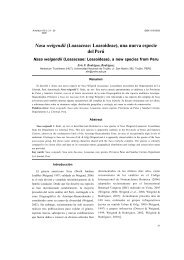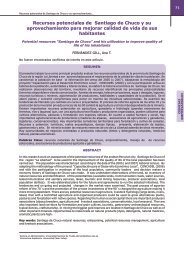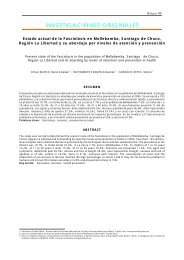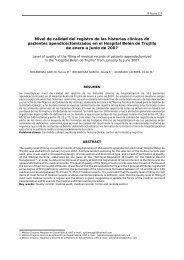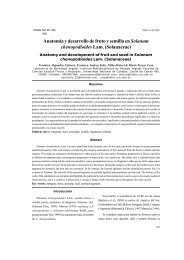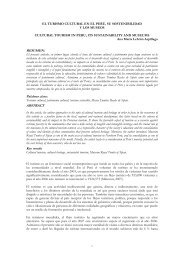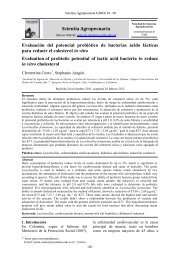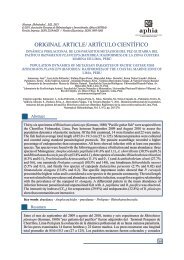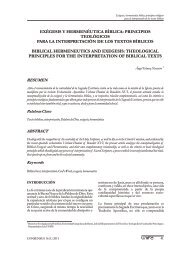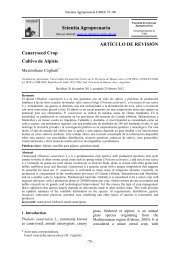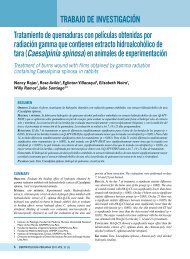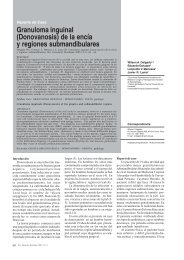temas libres presentados en el xxvi congreso ... - Revista Peruana
temas libres presentados en el xxvi congreso ... - Revista Peruana
temas libres presentados en el xxvi congreso ... - Revista Peruana
Create successful ePaper yourself
Turn your PDF publications into a flip-book with our unique Google optimized e-Paper software.
38Conclusions: Mechanical v<strong>en</strong>tilation is a usefuland necessary in critically ill neonates, but isassociated with high mortality and morbidity.Preval<strong>en</strong>cia retinopatía de la prematuridadhospital regional Doc<strong>en</strong>te las Mercedes-Chiclayo 2007-2009.Dra. Carm<strong>en</strong> I. Gutiérrez Gutiérrez 1RESUMEN:Introducción: La ROP trastorno complejo ymultifactorial de los niños prematuros, constituy<strong>en</strong>la tercera causa de ceguera <strong>en</strong> países <strong>en</strong>desarrollo, por lo que <strong>el</strong> tamizaje, prev<strong>en</strong>ción,diagnostico y tratami<strong>en</strong>to oportunos contribuirána mejorar a disminuir la morbilidad y mejorar lacalidad de vida de los niños.Objetivo: Conocer la preval<strong>en</strong>cia y factoresde riesgo asociados a ROP, <strong>en</strong> <strong>el</strong> Servicio deNeonatología <strong>en</strong> periodo de tres años.Material y Métodos: Estudio longitudinal,descriptivo, retrospectivo, se incluy<strong>en</strong> 343 RNPT m<strong>en</strong>ores de 2000 gr registrados la fichaROP periodo 2007-2009 tomando <strong>en</strong> cu<strong>en</strong>ta losdiagnostico ROP características, factores deriesgo: sexo, edad gestacional, peso al nacer,Apgar, asfixia neonatal, sepsis, suplem<strong>en</strong>to deoxig<strong>en</strong>o, SDR, surfactante, esteroides sistémicos,transfusiones.Resultados: D<strong>el</strong> total de niños tamizados sediagnóstico ROP <strong>en</strong> 175. características: ROP I45%, ROP II 46%, ROP III plus 7%, ROPIII 105,ROP plus 2%, ROP IV 2%, referidos para cirugíaláser 37%, sexo 31% masculino, 31% fem<strong>en</strong>ino.Edad gestacional 66% m<strong>en</strong>or de 32 semanas.Peso al nacer 64%, m<strong>en</strong>ores de 1500 gr 79%,recib<strong>en</strong> oxig<strong>en</strong>o 75%, asfixia neonatal 5%,sepsis 50%, transfusiones 10%, surfactante 975,esteroides sistémicos 25, SDR 67%.Conclusiones: El mayor porc<strong>en</strong>taje de RNPTcon ROP se <strong>en</strong>cu<strong>en</strong>tra <strong>en</strong>tre los m<strong>en</strong>ores de1500 gr., <strong>en</strong>contrándose como factor de riesgo<strong>el</strong> suplem<strong>en</strong>to de O2, <strong>el</strong> que se administra sinmezclador ni humidificador, SDR y sepsis. Se hac<strong>en</strong>ecesaria la mejor implem<strong>en</strong>tación para brindaroptima at<strong>en</strong>ción y disminuir algunos factores deriesgo.Retinopathy prematurity preval<strong>en</strong>ce atRegional Hospital las Mercedes-Chiclayo2007-2009.ABSTRACT:Introduction: ROP complex and multifactorialdisorder of premature infants, are the third leadingcause of blindness in dev<strong>el</strong>oping countries, so thescre<strong>en</strong>ing, prev<strong>en</strong>tion, diagnosis and treatm<strong>en</strong>tcontribute to improve to reduce morbidity andimprove quality of life childr<strong>en</strong>.Objective: To determine the preval<strong>en</strong>ce and riskfactors associated with ROP in the NeonatologyService in a period of three years.Material and Methods: A longitudinal, descriptive,retrospective, including 343 PT RN registeredunder 2000 gr ROP tab period 2007-2009 takinginto account the characteristics ROP diagnosis,risk factors: g<strong>en</strong>der, gestational age, birth weight,Apgar , neonatal asphyxia, sepsis, oxyg<strong>en</strong>, RDS,surfactant, systemic steroids, blood transfusions.Results: Of all childr<strong>en</strong> scre<strong>en</strong>ed for ROP wasdiagnosed in 175. Features: ROP I 45% II 46%ROP, ROP III plus 7% ROPIII 105, ROP plus2%, 2% IV ROP referred for laser surgery 37%,31% male sex, 31% female. 66% gestational ag<strong>el</strong>ess than 32 weeks. Birth weight 64% less than1500 g 79%, 75% received oxyg<strong>en</strong>, 5% neonatalasphyxia, sepsis 50%, 10% transfusion, surfactant975, systemic steroids 25, SDR 67%.Conclusions: The highest perc<strong>en</strong>tage of preterminfants with ROP is among those under 1500 gr.,Being a risk factor for supplem<strong>en</strong>tal O2, whichis giv<strong>en</strong> without a mixer or humidifier, RDS andsepsis. It is imperative to better implem<strong>en</strong>tation foroptimal care and reduce risk factors.Reporte de caso: Bebé colodiónLlontop Panta Margarita D<strong>el</strong> Pilar; Bambar<strong>en</strong> PáezEnrique, Prevost Ruiz Yolanda, Webb LinaresVerónica, Pacheco D<strong>el</strong>gado Kar<strong>en</strong>; Altamirano JuanRESUMEN:Introducción: El "Bebé colodión" es una forma rarade dermatosis ictiosiforme congénita, pres<strong>en</strong>tanuna membrana dura (“c<strong>el</strong>ofán”) que cubre todo<strong>el</strong> cuerpo (colodión). Diagnóstico es clínico, la



